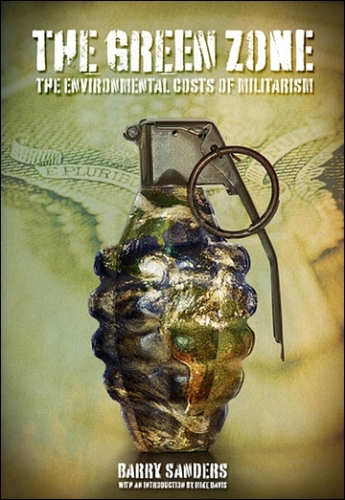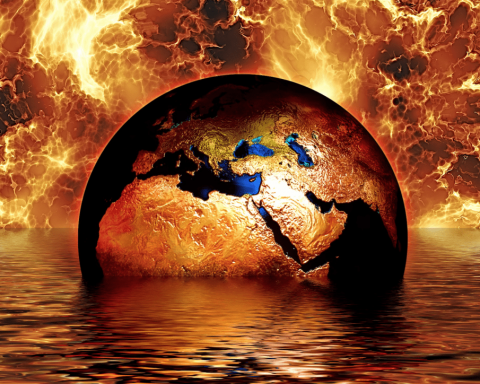The Green Zone: The Environmental Costs of Militarism by Barry Sanders, AK Press, 2009
Reviewed by Shannan Vance-Ocampo View and Print as PDF.
View and Print as PDF.
 In the wake of Hurricane Sandy and for those of us concerned about environmental damage and how to work against it, this book is an important read. It asks the central question: what about the environmental costs of militarism? Usually we count bodies, or people, budget numbers, or years of a conflict. But what if we counted the costs to Creation?
In the wake of Hurricane Sandy and for those of us concerned about environmental damage and how to work against it, this book is an important read. It asks the central question: what about the environmental costs of militarism? Usually we count bodies, or people, budget numbers, or years of a conflict. But what if we counted the costs to Creation?
What does war and militarism do to the environment? What about the recent military quagmires and their environmental damage in places like Iraq and Afghanistan? This book answers these questions. The answers are shocking and should call us to even greater attention and urgency around peacemaking in our time.
Simply put, militarism is the #1 threat to Creation.
The writer Barry Sanders reminds us that we all know the typical “to do” list of ways to combat environmental harm—recycle, compost, use solar energy, eliminate plastic, eat fewer animals, and so on. But what should be on these popular lists, never is—eliminate militarism. Sanders argues that the U.S. military is the “single largest source of pollution in this country and in the world.” This proverbial “200-pound gorilla in the living room” rarely gets a mention when we talk about reducing our environmental impact. And the situation is urgent. Sanders eloquently argues that, even if every single one of us on Planet Earth took all the “green steps” recommended by the experts. the world would still be hurtling toward environmental and climate disaster because of the huge footprint that militarism in all its forms exacts on the earth.
This book is a wake-up call about why our congregational and denominational ministry around peacemaking is so essential. While faith communities are awakening to the promise of environmental ministries, militarism is often the taboo topic, with many thinking that it would somehow turn off their followers. Two years ago I finished a Fellowship Program with a nationwide interfaith environmental organization. But when I brought up issues of militarism, the other people in my program didn’t want to have the conversation. Don’t we, though, have a responsibility as people of faith to begin these conversations?
A few shocking statistics from the book to pique your interest:
- An F-16 fighter jet at peak thrust uses 28 gallons of jet fuel per minute, or 1,680 gallons per hour—which, in that one hour, is as much as the average driver in an average car uses in three years.
- Depleted uranium is in the tips of most bombs that have been dropped in our recent war-making around the world, especially since 1991. This accounts for thousands upon thousands of birth defects and deformities of children. Common birth defects include missing limbs, damage to cells, memory loss, organ malfunction, and life-long impairments. Depleted uranium continues to emit radioactivity over a 4.5 billion year half life. And the victims aren’t just children in war-zones; our soldiers are coming home with all sorts of cancers and untreatable illnesses that have direct links back to depleted uranium. These soldiers pass these malignancies and deformities on to their yet unborn children—since their DNA and cell structure has changed. The U.S. Department of Veterans Affairs keeps no records on birth defects that occur in military families.
- 800 Tomahawk cruise missiles were dropped into Baghdad alone from March 20-21, 2003. This comes out to 1 every 4 minutes and represents 800 pounds of depleted uranium in each 3,000-pound bomb. This means that in just two days we dropped 320 tons of this poison on Baghdad alone.
There is much more in this book—so many details that would take pages to unpack. It seems to me, as a person of faith, that this book asks some important questions of us and offers opportunities for ministry and witness as people who follow the nonviolent Christ.
- What would it look like for the Church to stand against militarism based on the call in Genesis to care for the Creation?
- What is the proper role for lament, healing, justice, and reconciliation in regards to the Creation and its people after war?
- What would it look like for the Church to offer ministries of compassion and healing to those whose bodies have been ravaged by the toxicity of militarism?
- How can we faithfully highlight the issue of militarism on Earth Care Sunday each April?
- How can we as people of faith lift up these issues when the topic of “caring for Creation” comes up in our congregations?
This book has been an essential part of my ongoing awakening to the costs of militarism. I need the information and statistics it provides if I am going to be able to talk about the costs of militarism when we think about God’s Creation. Our denomination has begun a study on peacemaking and nonviolence through our Peace Discernment Process. I hope that these conversations around God’s beloved Creation can be part of the conversations each one of us have with our communities of faith. And when we look at the devastation of the recent Hurricane Sandy and we hear conversation about how global warming contributed to its ferocity—remember this: all the changes to our habits and lifestyles are not enough. We must also end militarism.
Learn more about The Green Zone by Barry Sanders
Read more articles like this one in the Nov 2012–Jan 2013 issue, “Hope for Eco-Activists: Discovering an Environmental Faith“
Rev. Shannan Vance-Ocampo serves as Pastor to the Watchung Avenue Presbyterian Church in North Plainfield, NJ, and on the National Committee of the Presbyterian Peace Fellowship where she helps with the Colombia Accompaniment Program. Shannan has been traveling to Colombia for the last 13 years and has had the opportunity there to witness firsthand the effects of militarism and its accompanying environmental damage. She is a Fellow with GreenFaith and a Certified Christian Educator in the PC(USA).







Unbound Social